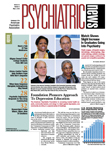How would you like to take a virtual trip on the London underground—the “tube”—to find out how paranoid you are?
Two hundred British citizens did just that, as part of a study by a research group led by Daniel Freeman, Ph.D., a Wellcome Trust fellow at the Institute of Psychiatry in London. The subjects were a representative sample of the local population.
Each subject was required to wear a head-mounted, virtual-display device that featured a high-resolution, 3-D view of a single train car compartment. The animated travelers seen inside the compartment were computer-generated, avatar-styled, human-like characters. The background noise heard consisted of snippets of human conversation and the sound of a moving train.
After taking the same four-minute virtual tube trip between two stops, the subjects were asked to report their experiences with the computer characters they had encountered on the trip. Sixty percent reported positive or neutral experiences, such as “One guy was checking me out—flattering,” or “It felt like a normal tube. People were just trying to get where they wanted to go.”
Forty percent of the subjects, though, reported negative experiences, such as “There was a man who tried to stare me out” or “A lady sitting down laughed at me when I walked past.” In short, the latter seemed to be thinking paranoid thoughts.
In fact all of the subjects had been assessed for trait paranoia—paranoid thoughts in day-to-day life—before the virtual trip, and subjects who reported such thoughts, the researchers learned, were about twice as likely to experience paranoia during the virtual trip as were subjects who reported no paranoid thoughts. This difference was highly significant.
So it appears that about 40 percent of the general population experiences paranoid thoughts at some time or at least under certain conditions, Freeman and his colleagues reported in the April British Journal of Psychiatry.
Freeman told Psychiatric News, “Traditionally, paranoid thoughts have been thought of as a symptom of severe mental illnesses, such as schizophrenia. This study clearly shows that paranoia is much more common than that.”
Moreover, Freeman and his coworkers used their virtual-reality test to identify some of the causes of paranoid thinking. They assessed their subjects for worry, life stressors, social support, loneliness, and other psychological factors before the subjects took the virtual tube trip. Then after the trip, the researchers looked for links between any of those factors and experiencing paranoia during the trip.
Such links did appear, they noted. Worry, subtle perceptual anomalies, and inflexibility in thinking about how to deal with situations were significantly linked with paranoia, and even when possibly confounding factors were considered. “It is also of interest that women and those who regularly used the London underground reported less paranoia,” the researchers noted.
But perhaps the greatest benefits to emerge from this study, the researchers believe, are not their particular findings, but the broader implications of what they have embarked upon. First, they pointed out,“ We have demonstrated that virtual reality is a safe and acceptable method of studying paranoia in the laboratory.” In other words, none of the subjects reported any physical negative effects such as nausea, dizziness, or blurred vision from the experience.
Second, they noted, studying paranoia with virtual reality has an advantage over studying paranoia in the real world: computer characters can be programmed to behave in ways deemed by consensus to be neutral. As a result, researchers can be fairly confident that subjects' paranoid reactions are truly paranoia, not suspicions based on real threats.
Thus virtual reality holds “great promise” for studying paranoia, Freeman and his group concluded. For example, two or three different virtual-reality settings could be used with the same subjects to see whether they react with the same amounts of paranoia in each of those settings. Virtual reality could be used to explore the impact of terrorism on paranoid thinking in the general population or to compare paranoid reactions in the general population with those in patients with persecutory delusions. Indeed, virtual reality might even be incorporated into emerging cognitive-behavioral therapy for paranoia.

